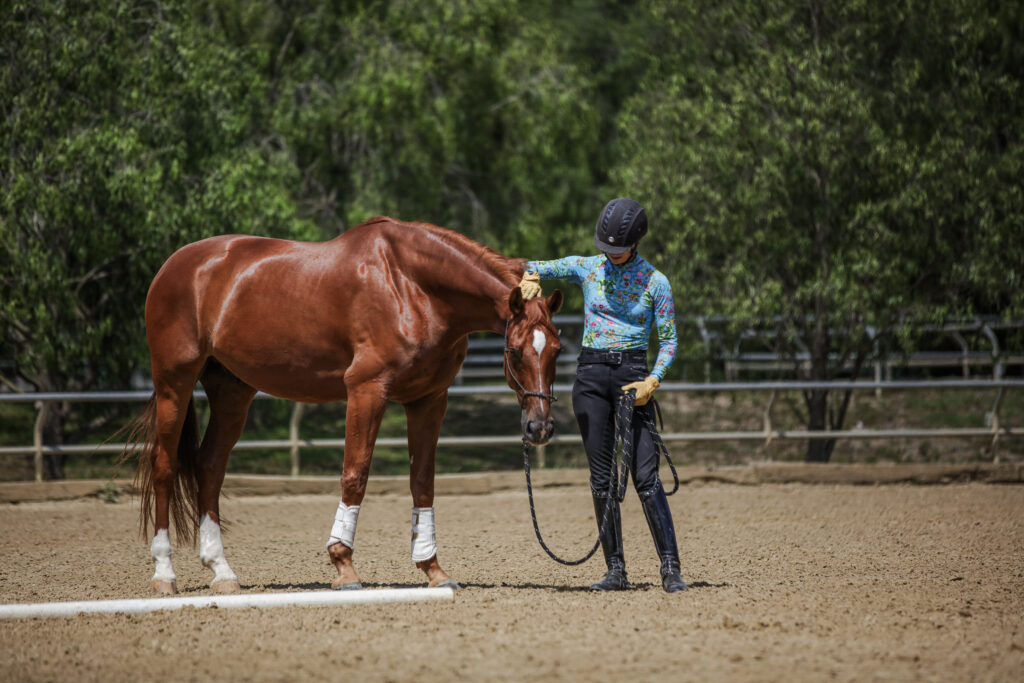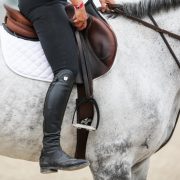How To Use Groundwork For Acceptance Of The Aids

Ever had a riding theory question you couldn’t find the answer to? Or don’t have a go-to coach to ask? In this recurring segment, Amelia Newcomb is here to answer anything about your riding and dressage needs.
Is it helpful to work on the ground/longe line to train a young horse to accept the aids? If so, what do you like to start with?
Yes, yes, yes! Teaching anything and everything from the ground first is helpful for a horse. Regardless of their age. Groundwork (in-hand, long-ling, longing, etc.), allows us to:
- breakdown the aids and movements into smaller parts for our horse to understand
- let our horse find their balance without carrying us
- physically SEE the reaction our horses are giving us (rather than trying to ‘feel’ it)
- stay safe if our horse is struggling (head tossing, bucking, spinning, etc)
There are 3 exercises to start with. Incorporating these into your daily routine will yield results almost immediately.
Transitions on the ground
This is simply just making sure that your horse walks when you walk, and stops when you stop. If you back up your horse should back up too. Practice this and see does your horse comply? They should be following your energy and watching for what you are doing. Practice this around the farm and try keeping yourself between your horse’s head and shoulders. Lead your horse forward with your right hand and when you want to stop, raise your left hand. Eventually, they will associate the hand movements with the commands.
Poll Release
This is important for bridling, helping your horse relax, and eventually teaching them how to go round over the back. When your horse lowers their head they relax. You start with your hand on the poll and also on the bit. Place downward pressure and as soon as their head comes down, reward them by releasing the pressure. Over time you continuously practice this until all you have to do is place your hand on the poll and the horse will drop their head down. Any time I feel my horses get externalized, I practice this to calm them down.
Bend and Yield
This is where we ask the horse with the inside rein to bend their body to the inside and get the inside hindleg to cross over the front of the outside hindleg. This creates suppleness and relaxation throughout their body and if you have the horse’s body relaxed, their mind will be more relaxed.

If you’re new to groundwork, it may take some time to develop the feel of it. But I promise it’s worth it.
If you’re comfortable with the three exercises above, there is so much more you can do. Anything you want your horse to do under saddle you can teach them how to do from the ground first.
The biggest thing I see riders struggling with under saddle is the concept of getting their horse connected and on the bit. And that is something I ALWAYS teach and refresh on the ground.
If you’re interested in learning how groundwork can help your horse get soft, supple, and on the bit, consider signing up for my 30 Days To Round Challenge. The challenge gets underway on Sept. 15!
Amelia Newcomb is a USDF Gold medalist. Based in Somis, California, she incorporates complete dressage training from starting the young horse through the FEI levels in both her in person and online programs. Amelia works to develop a trusting and confident relationship between horse and rider. Her approach incorporates all aspects of horsemanship from basic groundwork to advanced dressage movements. Amelia’s mantra has always been “Dressage for All”, which is evident in both her in person and online coaching. With a successful YouTube video library of hundreds of free educational videos, over 220,000 subscribers (and counting!), and thousands of students enrolled in her online USDF accredited courses.


